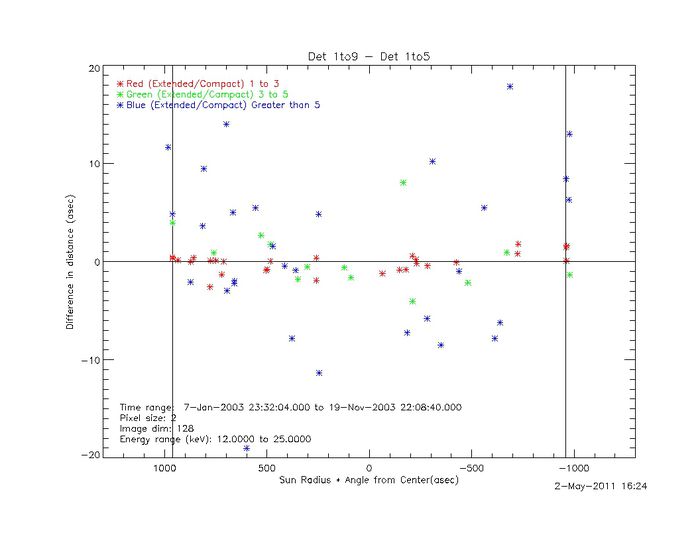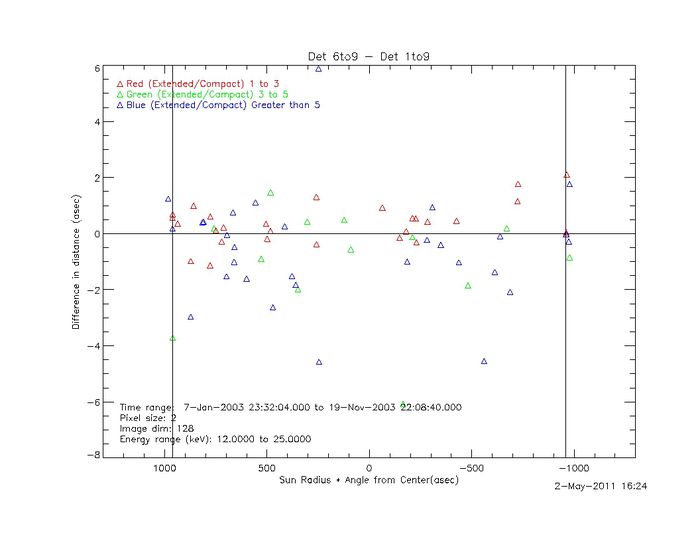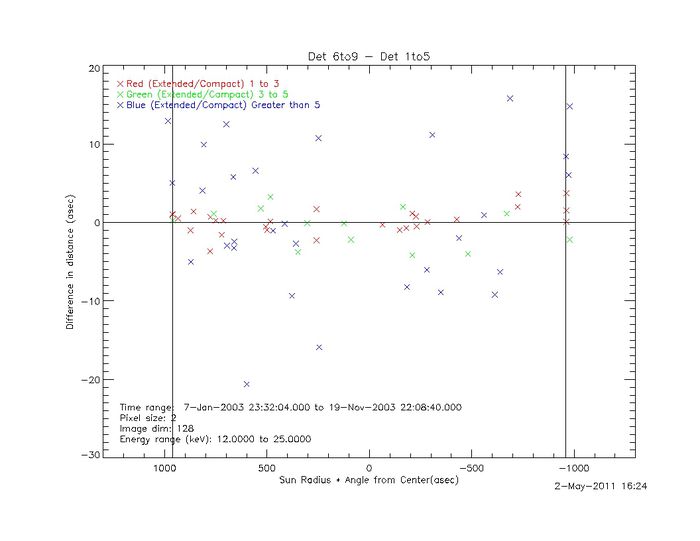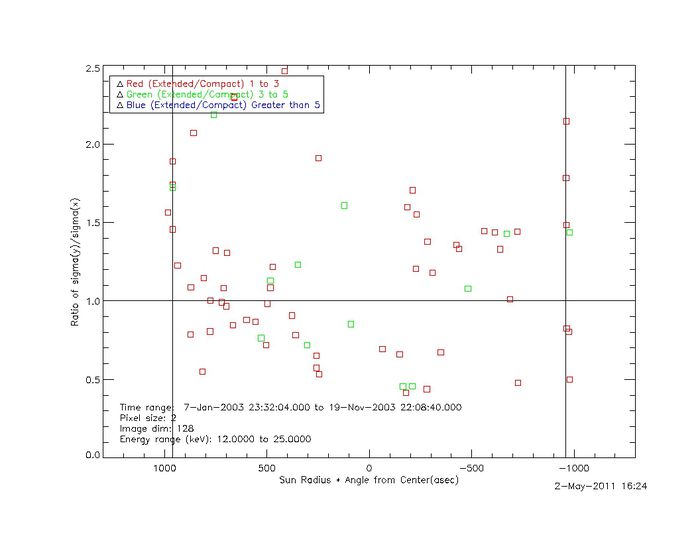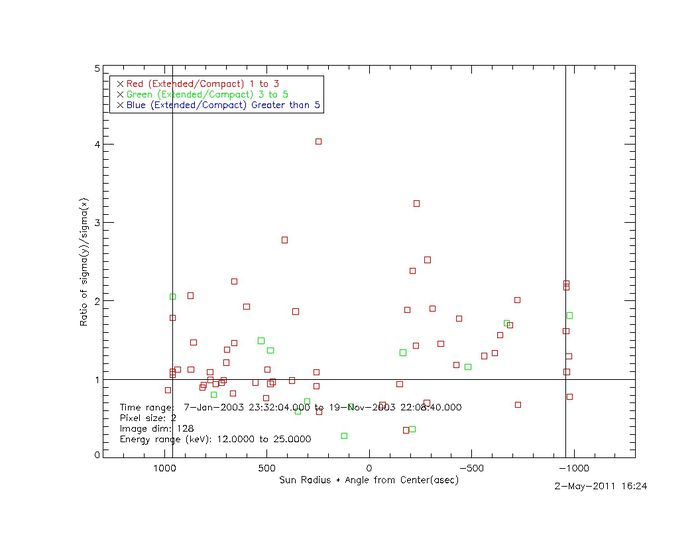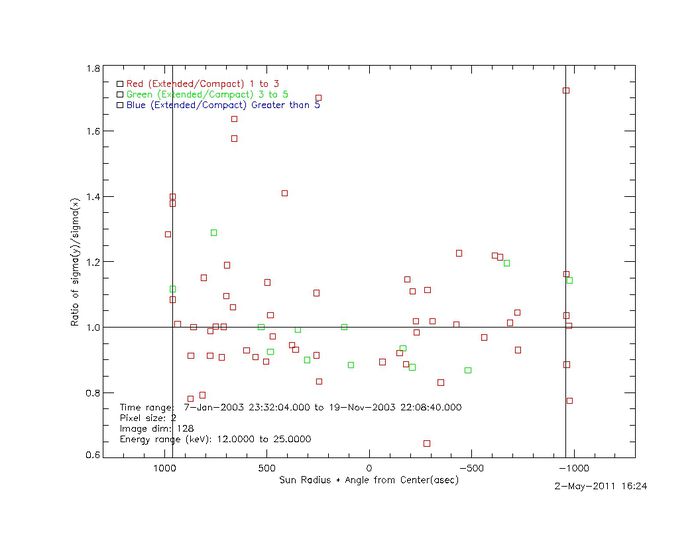Weekly Report 29Apr2011
From RHESSI Wiki
(→RHESSI Albedo Image Test) |
(→RHESSI Albedo Image Test) |
||
| Line 1: | Line 1: | ||
===RHESSI Albedo Image Test=== | ===RHESSI Albedo Image Test=== | ||
| + | RHESSI Clean Imaging techniques were used to image a large number of flares. For each flare three different detector combinations and two different energy bands were used. The following parameters were used: | ||
| + | The flares used were decided upon by the RHESSI response in the 25keV-50keV bands. | ||
| + | *Time: Decided by the peak of the 25keV-50keV energy band for each flare | ||
| + | *Energy: 12keV to 25keV, or 25keV to 50keV | ||
| + | *Detectors: 1 to 9, or 1 to 5,or 6 to 9 | ||
| + | *Pixel Size: 2 arcsec by 2 arcsec | ||
| + | *Image Size: 128 pixels by 128 pixels | ||
| + | *Clean Beam Width Factor = 2 | ||
| + | Clean images were made with each for each energy band with each detector combination. For each image the centroid of the source was measured, the total flux in the image was measured, and the standard deviation in the x and y direction for each source was measured. Using these measurements the plots below were made. | ||
| + | |||
| + | The plots were adjusted for the change in solar radius as observed from the earth at the time of the flare. All plots as a function of distance were made with an x axis as a ratio of the distance to limb at the time. An average value of 960 arcsec was added to the ratios for scaling purposes. | ||
| + | |||
| + | The plot below shows the distance to the limb in arcsec as a function of time. | ||
[[File:Limb loc.jpg|center|thumb|700px|The plot above shows the location of the limb in arcsecs as a function of UT]] | [[File:Limb loc.jpg|center|thumb|700px|The plot above shows the location of the limb in arcsecs as a function of UT]] | ||
| + | |||
| + | The plots below are summarized at below the series of plots. | ||
[[File:Ratio coarse fine.jpg|center|thumb|700px|The ratio of the flux from the images using detectors 6 to 9 divided by detectors 1 to 5.]] | [[File:Ratio coarse fine.jpg|center|thumb|700px|The ratio of the flux from the images using detectors 6 to 9 divided by detectors 1 to 5.]] | ||
Revision as of 02:39, 3 May 2011
RHESSI Albedo Image Test
RHESSI Clean Imaging techniques were used to image a large number of flares. For each flare three different detector combinations and two different energy bands were used. The following parameters were used: The flares used were decided upon by the RHESSI response in the 25keV-50keV bands.
- Time: Decided by the peak of the 25keV-50keV energy band for each flare
- Energy: 12keV to 25keV, or 25keV to 50keV
- Detectors: 1 to 9, or 1 to 5,or 6 to 9
- Pixel Size: 2 arcsec by 2 arcsec
- Image Size: 128 pixels by 128 pixels
- Clean Beam Width Factor = 2
Clean images were made with each for each energy band with each detector combination. For each image the centroid of the source was measured, the total flux in the image was measured, and the standard deviation in the x and y direction for each source was measured. Using these measurements the plots below were made.
The plots were adjusted for the change in solar radius as observed from the earth at the time of the flare. All plots as a function of distance were made with an x axis as a ratio of the distance to limb at the time. An average value of 960 arcsec was added to the ratios for scaling purposes.
The plot below shows the distance to the limb in arcsec as a function of time.
The plots below are summarized at below the series of plots.



